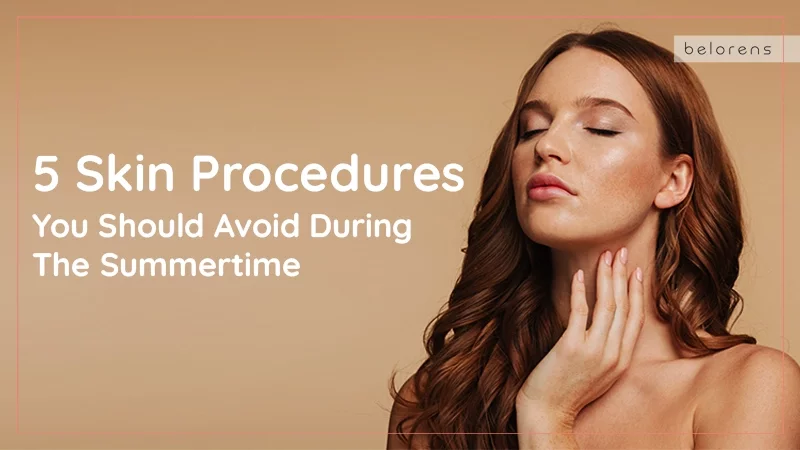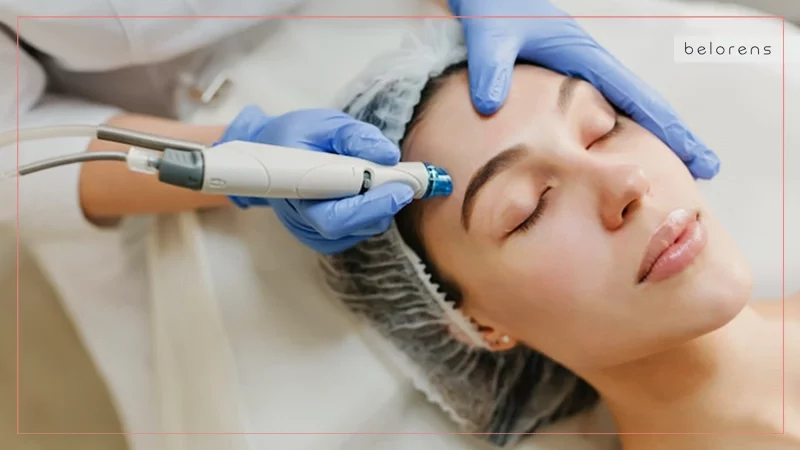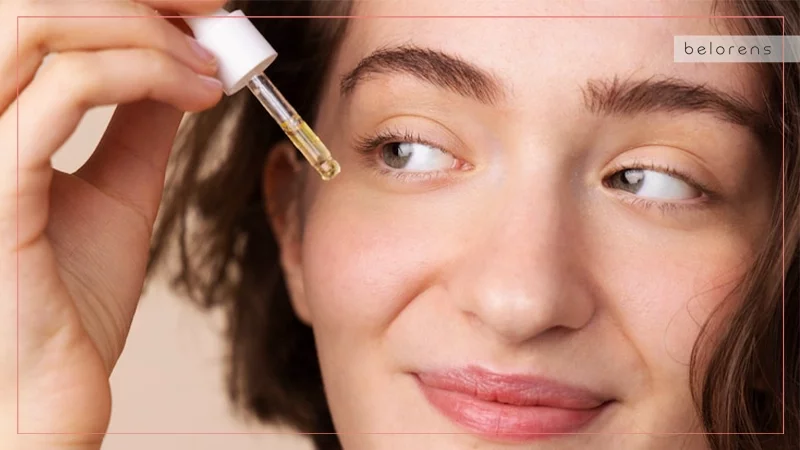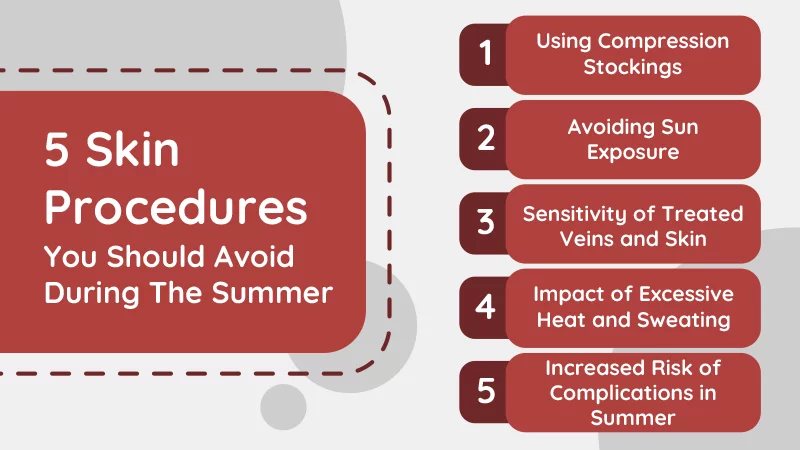Published on 6 Oct 2024 | Last updated on yesterday
5 Skin Procedures You Should Avoid During The Summertime
- ByMedical Content Team
- Medically Reviewed byDr. Sabine Kulhanek
Fact checked

Summer is a season of sunshine, beach outings, and long days spent outdoors. While the warm weather and golden rays bring joy and relaxation, they can also pose significant challenges to your skincare routine. UV exposure, increased sweat, and environmental factors make it crucial to adjust your skin treatments accordingly. In particular, some popular procedures can do more harm than good when the sun is at its peak.
As certain treatments can make your skin more vulnerable to the sun's harmful effects, it's essential to be mindful of the skin procedures you choose during the sun season. To help you maintain a glowing and healthy complexion, we’ve compiled a list of five skin procedures to avoid during the summertime. Understanding these precautions will ensure that your skin stays protected and radiant throughout the season. Read on to learn which treatments to sideline until the fall, and discover safer alternatives to keep your skin looking its best.
Chemical peels
Chemical peels are dermatological treatments involving the application of a chemical solution to the skin, causing the outer layers to exfoliate and peel off. This process reveals new, regenerated skin underneath, which is typically smoother and less wrinkled than the old skin. Chemical peels vary in strength, from superficial peels that target the outermost layer of the skin to deep peels that penetrate several layers. They are commonly used to treat various skin concerns, including fine lines and wrinkles, sun damage and age spots, acne scars, hyperpigmentation, and uneven skin tone and texture.
Why you should avoid chemical peels during the summer
While chemical peels offer numerous benefits, they are best avoided during the sunny summer months for several reasons:
- Chemical peels increase sun sensitivity because they remove the top layers of the skin, which act as a natural barrier against UV rays. This leaves the new skin more sensitive and susceptible to sunburn, even with diligent use of sunscreen. Even minimal sun exposure can cause significant damage, leading to skin redness, irritation, and an increased risk of long-term skin issues.
- There is a significant risk of hyperpigmentation; sun exposure after a chemical peel can lead to patches of skin becoming darker than the surrounding areas. This risk is particularly high during the summer when UV intensity is at its peak.
- The healing process following a chemical peel can be compromised by sun exposure. UV rays can interfere with the skin's ability to recover, leading to prolonged redness, peeling, and discomfort.
- The risk of complications, such as infections, prolonged inflammation, and scarring, is heightened when the skin's barrier is compromised and exposed to intense UV rays.
Microdermabrasion

Microdermabrasion is a non-invasive cosmetic procedure designed to exfoliate the skin and remove dead skin cells from the outermost layer. This treatment uses a special applicator with an abrasive surface to gently sand the skin, or a fine mist of abrasive particles, to achieve the same result. The procedure helps to rejuvenate the skin, making it look brighter and feel smoother. It is commonly used to address skin concerns such as fine lines, wrinkles, sun damage, age spots, acne scars, and uneven skin tone and texture.
Why you should avoid microdermabrasion during the summer
While microdermabrasion offers several skin benefits, it is advisable to avoid this procedure during the summer for a few important reasons:
- Microdermabrasion increases your skin's sensitivity to the sun. By removing the outer layer of skin, this treatment exposes newer, more delicate skin that lacks the protective barrier that helps shield against UV rays. This heightened sensitivity can make your skin more susceptible to sunburn, even with the application of sunscreen. This can cause significant issues like redness, irritation, and peeling. Sunburn on freshly treated skin can lead to prolonged discomfort and potential long-term skin problems.
- Undergoing microdermabrasion in the summer can elevate the risk of hyperpigmentation. The sun's UV rays are more intense during the summer, and exposing freshly exfoliated skin to these rays can lead to uneven pigmentation, where some areas of the skin become darker than others. This risk is particularly high for individuals with darker skin tones.
- The healing process post-microdermabrasion can be negatively impacted by sun exposure. UV rays can interfere with the skin’s ability to recover, leading to extended periods of redness, peeling, and overall discomfort.
- There is an increased risk of complications. The combination of a compromised skin barrier and intense UV exposure can heighten the risk of issues such as infections, prolonged inflammation, and scarring.
Laser treatments
Laser treatments encompass a variety of dermatological procedures that use focused light energy to target specific skin concerns. Common laser treatments include laser hair removal, laser skin resurfacing, and treatments for pigmentation, vascular lesions, and acne scars. These treatments work by emitting light at specific wavelengths, which are absorbed by the targeted tissue, causing controlled damage that stimulates the skin’s natural healing processes. This can result in smoother, clearer, and more evenly toned skin.
Why you should avoid laser treatments during the summer
While laser treatments can be highly effective, they are best avoided during the summer months for several critical reasons:
- Laser treatments increase the skin’s sensitivity to sunlight. The procedure involves targeting and disrupting the skin’s surface and deeper layers, which can leave the skin more vulnerable to UV damage. This heightened sensitivity can significantly increase the risk of sunburn, even with the use of sunscreen. Sunburn on recently treated skin can result in severe discomfort, redness, and peeling, which can extend the healing period and increase the risk of complications.
- Undergoing laser treatments in the summer can lead to hyperpigmentation. After a laser procedure, the skin is more prone to developing pigmentation issues when exposed to sunlight. UV exposure can cause the treated areas to become darker or develop uneven pigmentation, counteracting the benefits of the treatment and leading to further skin concerns.
- The risk of complications is elevated during the summer. The combination of a compromised skin barrier and intense UV exposure can lead to undesirable outcomes such as prolonged inflammation, pigmentation changes, and infections, which can be difficult to treat and may require additional interventions.
Retinoid treatments

Retinoid treatments involve the use of Vitamin A derivatives, such as retinol, tretinoin, and adapalene, which are commonly used in skincare for their powerful anti-aging and acne-fighting properties. These treatments work by increasing cell turnover, promoting the shedding of dead skin cells, and stimulating the production of new skin cells. This can lead to smoother, clearer, and more youthful-looking skin, reducing the appearance of fine lines, wrinkles, and acne.
Why you should avoid retinoid treatments during the summer
While retinoid treatments offer significant benefits for the skin, they are best avoided during the summer months for several important reasons.
- Retinoids increase the skin’s sensitivity to sunlight. By promoting rapid cell turnover and thinning the outer layer of the skin, retinoids leave the skin more exposed and vulnerable to UV radiation. This heightened sensitivity can lead to a higher risk of sunburn, even with the application of sunscreen, leading to redness, irritation, and peeling, which can be uncomfortable and potentially harmful.
- Using retinoids in the summer can exacerbate the risk of hyperpigmentation. When the newly exposed skin cells are subjected to intense UV rays, there is a greater likelihood of developing uneven pigmentation and dark spots. This risk is particularly high during the summer when UV intensity is at its peak.
- The healing process post-retinoid application can be disrupted by sun exposure. UV rays can interfere with the skin’s ability to recover, leading to prolonged redness, dryness, and overall discomfort. This can also reduce the effectiveness of the treatment and prolong the time needed to see results.
- The combination of retinoid-induced skin sensitivity and intense UV exposure can lead to undesirable outcomes such as prolonged inflammation, severe dryness, and the potential for long-term damage. These complications can be difficult to manage and may require additional treatments to address.
Also Read: The Ultimate Guide to Making a Skincare Routine: Tips for Healthy Skin
Sclerotherapy
Sclerotherapy is a medical procedure used to treat varicose veins and spider veins. It involves injecting a solution directly into the affected veins, causing them to scar and collapse. The collapsed vein is eventually absorbed by the body, redirecting blood flow to healthier veins. Over time, the treated veins fade from view, leading to an improved appearance of the skin. Sclerotherapy is commonly performed to alleviate symptoms associated with varicose veins, such as aching, swelling, and burning sensations, as well as to improve the cosmetic appearance of the legs.
Why you should avoid sclerotherapy during the summer

While sclerotherapy can be highly effective in treating varicose and spider veins, it is advisable to avoid this procedure during the sun season for several reasons.
- Sclerotherapy often requires wearing compression stockings after the treatment to help support vein closure and reduce swelling. These stockings can be uncomfortable and hot during the warm summer months, making adherence to post-procedure care more challenging. Wearing compression stockings in the heat can also lead to skin irritation and discomfort.
- After sclerotherapy, it is important to avoid sun exposure to the treated areas. UV rays can exacerbate post-procedure bruising and pigmentation changes, leading to undesirable cosmetic outcomes. Sun exposure can also increase the risk of complications, such as inflammation and hyperpigmentation in the treated areas.
- The treated veins and surrounding skin can be more sensitive after sclerotherapy. Exposing these areas to the sun can lead to increased irritation, redness, and the potential for prolonged healing times. This heightened sensitivity can make it difficult to enjoy outdoor summer activities without risking adverse effects.
- Excessive heat and sweating can interfere with the healing process following sclerotherapy. Heat can cause blood vessels to dilate, which might counteract the effects of the treatment and lead to less satisfactory results. Sweating can also increase the risk of infection and skin irritation around the injection sites.
- The overall risk of complications is higher during the summer. The combination of increased sun exposure, heat, and the need for post-procedure care can lead to a higher likelihood of issues such as swelling, pigmentation changes, and discomfort. These complications can detract from the desired outcomes of the treatment and may require additional interventions to address.
Tips to minimize risks when undergoing these treatments in summer
If you decide to undergo the above-mentioned treatments during the summer, it's essential to take extra precautions to protect your skin. Here are some comprehensive tips to ensure your skin stays healthy and your treatment results are optimized:
Use broad-spectrum sunscreen
Apply a broad-spectrum sunscreen with at least SPF 30 every day, regardless of whether you're indoors or outdoors. Reapply every two hours, or more often if you are swimming or sweating. Choose a sunscreen that offers protection against both UVA and UVB rays.
Avoid direct sunlight
Stay indoors as much as possible, especially during peak UV radiation hours from 10 a.m. to 4 p.m. If you need to be outside, seek shade whenever possible to minimize sun exposure.
Wear protective clothing
Use clothing as a physical barrier against the sun. Wear wide-brimmed hats, long sleeves, and long pants made of tightly woven fabrics to cover your skin. Consider clothes with built-in UV protection for added safety.
Use physical barriers
Utilize umbrellas or portable sun shelters when spending time outdoors. Physical barriers can provide an extra layer of protection, reducing the risk of sun exposure to sensitive areas.
Hydrate and moisturize
Keep your skin hydrated by drinking plenty of water throughout the day. Regularly moisturize your skin to maintain its barrier function and support the healing process. Choose moisturizers that are gentle and free of irritants.
Apply retinoids and other active ingredients at night
If you are using retinoids or other active ingredients, apply them at night to reduce the risk of sun sensitivity. Ensure you wash your face in the morning to remove any residue before applying sunscreen.
Follow post-procedure care instructions
Adhere strictly to the aftercare instructions provided by your dermatologist or healthcare provider. These instructions are designed to help your skin heal properly and minimize the risk of complications.
Avoid heat and sweating
Try to stay in cool environments and avoid activities that cause excessive sweating. Heat and sweat can irritate treated skin and potentially interfere with the healing process.
Monitor your skin
Keep an eye on your skin for any signs of adverse reactions, such as increased redness, swelling, or unusual pigmentation. Contact your healthcare provider immediately if you notice any concerning changes.
By following these skin protection tips, you can help mitigate the risks associated with undergoing these procedures during the summer and maintain the health and appearance of your skin.




